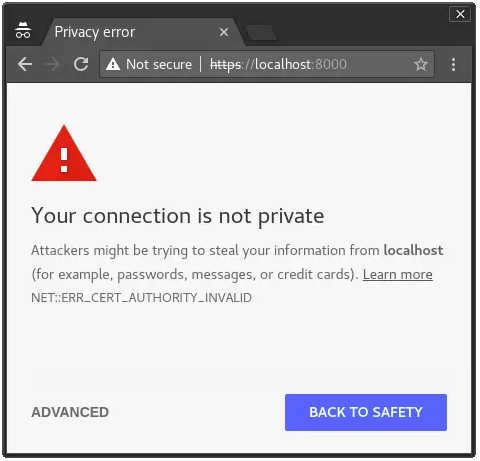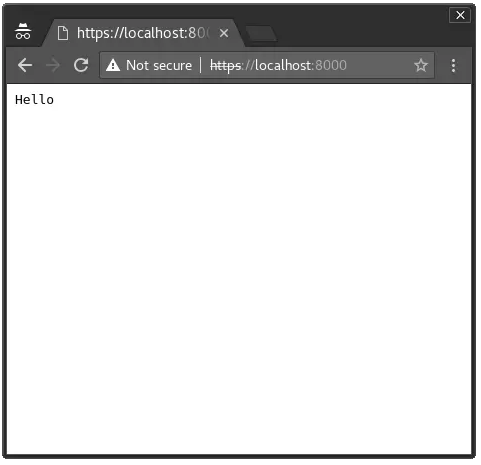關於Go語言的http/2伺服器功能及使用者端使用方法
前言
大家都知道,Go的標準庫HTTP伺服器預設支援HTTP/2。那麼,在這篇文章中,我們將首先展示Go的http/2伺服器功能,並解釋如何將它們作為使用者端使用。
在這篇文章中,我們將首先展示Go的http/2伺服器功能,並解釋如何將它們作為使用者端使用。Go的標準庫HTTP伺服器預設支援HTTP/2。
下面話不多說了,來一起看看詳細的介紹吧
HTTP/2 伺服器
首先,讓我們在Go中建立一個http/2伺服器!根據http/2檔案,所有東西都是為我們自動設定的,我們甚至不需要匯入Go的標準庫http2包:
HTTP/2強制使用TLS。為了實現這一點,我們首先需要一個私鑰和一個證書。在Linux上,下面的命令執行這個任務。
openssl req -newkey rsa:2048 -nodes -keyout server.key -x509 -days 365 -out server.crt
該命令將生成兩個檔案:server.key 以及 server.crt
現在,對於伺服器程式碼,以最簡單的形式,我們將使用Go的標準庫HTTP伺服器,並啟用TLS與生成的SSL檔案。
package main
import (
"log"
"net/http"
)
func main() {
// 在 8000 埠啟動伺服器
// 確切地說,如何執行HTTP/1.1伺服器。
srv := &http.Server{Addr:":8000", Handler: http.HandlerFunc(handle)}
// 用TLS啟動伺服器,因為我們執行的是http/2,它必須是與TLS一起執行。
// 確切地說,如何使用TLS連線執行HTTP/1.1伺服器。
log.Printf("Serving on https://0.0.0.0:8000")
log.Fatal(srv.ListenAndServeTLS("server.crt", "server.key"))
}
func handle(w http.ResponseWriter, r *http.Request) {
// 記錄請求協定
log.Printf("Got connection: %s", r.Proto)
// 向客戶傳送一條訊息
w.Write([]byte("Hello"))
}HTTP/2 使用者端
在go中,標準 http.Client 也用於http/2請求。惟一的區別是在使用者端的Transport欄位,使用 http2.Transport 代替 http.Transport。
我們生成的伺服器證書是「自簽名」的,這意味著它不是由一個已知的證書頒發機構(CA)簽署的。這將導致我們的使用者端不相信它:
package main
import (
"fmt"
"net/http"
)
const url = "https://localhost:8000"
func main() {
_, err := http.Get(url)
fmt.Println(err)
}讓我們試著執行它:
$ go run h2-client.go Get https://localhost:8000: x509: certificate signed by unknown authority
在伺服器紀錄檔中,我們還將看到使用者端(遠端)有一個錯誤:
http: TLS handshake error from [::1]:58228: remote error: tls: bad certificate
為了解決這個問題,我們可以用客製化的TLS設定去設定我們的使用者端。我們將把伺服器證書檔案新增到使用者端「證書池」中,因為我們信任它,即使它不是由已知CA簽名的。
我們還將新增一個選項,根據命令列標誌在HTTP/1.1和HTTP/2傳輸之間進行選擇。
package main
import (
"crypto/tls"
"crypto/x509"
"flag"
"fmt"
"io/ioutil"
"log"
"net/http"
"golang.org/x/net/http2"
)
const url = "https://localhost:8000"
var httpVersion = flag.Int("version", 2, "HTTP version")
func main() {
flag.Parse()
client := &http.Client{}
// Create a pool with the server certificate since it is not signed
// by a known CA
caCert, err := ioutil.ReadFile("server.crt")
if err != nil {
log.Fatalf("Reading server certificate: %s", err)
}
caCertPool := x509.NewCertPool()
caCertPool.AppendCertsFromPEM(caCert)
// Create TLS configuration with the certificate of the server
tlsConfig := &tls.Config{
RootCAs: caCertPool,
}
// Use the proper transport in the client
switch *httpVersion {
case 1:
client.Transport = &http.Transport{
TLSClientConfig: tlsConfig,
}
case 2:
client.Transport = &http2.Transport{
TLSClientConfig: tlsConfig,
}
}
// Perform the request
resp, err := client.Get(url)
if err != nil {
log.Fatalf("Failed get: %s", err)
}
defer resp.Body.Close()
body, err := ioutil.ReadAll(resp.Body)
if err != nil {
log.Fatalf("Failed reading response body: %s", err)
}
fmt.Printf(
"Got response %d: %s %s\n",
resp.StatusCode, resp.Proto, string(body)
)
}這一次我們得到了正確的迴應:
$ go run h2-client.go Got response 200: HTTP/2.0 Hello
在伺服器紀錄檔中,我們將看到正確的紀錄檔線:獲得連線:Got connection: HTTP/2.0!!
但是當我們嘗試使用HTTP/1.1傳輸時,會發生什麼呢?
$ go run h2-client.go -version 1 Got response 200: HTTP/1.1 Hello
我們的伺服器對HTTP/2沒有任何特定的東西,所以它支援HTTP/1.1連線。這對於向後相容性很重要。此外,伺服器紀錄檔表明連線是HTTP/1.1:Got connection: HTTP/1.1。
HTTP/2 高階特性
我們建立了一個HTTP/2客戶機-伺服器連線,並且我們正在享受安全有效的連線帶來的好處。但是HTTP/2提供了更多的特性,讓我們來研究它們!
伺服器推播
HTTP/2允許伺服器推播「使用給定的目標構造一個合成請求」。
這可以很容易地在伺服器處理程式中實現(在github上的檢視):
func handle(w http.ResponseWriter, r *http.Request) {
// Log the request protocol
log.Printf("Got connection: %s", r.Proto)
// Handle 2nd request, must be before push to prevent recursive calls.
// Don't worry - Go protect us from recursive push by panicking.
if r.URL.Path == "/2nd" {
log.Println("Handling 2nd")
w.Write([]byte("Hello Again!"))
return
}
// Handle 1st request
log.Println("Handling 1st")
// Server push must be before response body is being written.
// In order to check if the connection supports push, we should use
// a type-assertion on the response writer.
// If the connection does not support server push, or that the push
// fails we just ignore it - server pushes are only here to improve
// the performance for HTTP/2 clients.
pusher, ok := w.(http.Pusher)
if !ok {
log.Println("Can't push to client")
} else {
err := pusher.Push("/2nd", nil)
if err != nil {
log.Printf("Failed push: %v", err)
}
}
// Send response body
w.Write([]byte("Hello"))
}使用伺服器推播
讓我們重新執行伺服器,並測試客戶機。
對於HTTP / 1.1使用者端:
$ go run ./h2-client.go -version 1 Got response 200: HTTP/1.1 Hello
伺服器紀錄檔將顯示:
Got connection: HTTP/1.1Handling 1st
Can't push to client
HTTP/1.1使用者端傳輸連線產生一個 http.ResponseWriter 沒有實現http.Pusher,這是有道理的。在我們的伺服器程式碼中,我們可以選擇在這種客戶機的情況下該做什麼。
對於HTTP/2客戶:
go run ./h2-client.go -version 2 Got response 200: HTTP/2.0 Hello
伺服器紀錄檔將顯示:
Got connection: HTTP/2.0Handling 1st
Failed push: feature not supported
這很奇怪。我們的HTTP/2傳輸的使用者端只得到了第一個「Hello」響應。紀錄檔表明連線實現了 http.Pusher 介面——但是一旦我們實際呼叫 Push() 函數——它就失敗了。
排查發現,HTTP/2使用者端傳輸設定了一個HTTP/2設定標誌,表明推播是禁用的。
因此,目前沒有選擇使用Go客戶機來使用伺服器推播。
作為一個附帶說明,google chrome作為一個使用者端可以處理伺服器推播。


伺服器紀錄檔將顯示我們所期望的,處理程式被呼叫兩次,路徑 / 和 /2nd,即使客戶實際上只對路徑 /:
Got connection: HTTP/2.0Handling 1st
Got connection: HTTP/2.0Handling 2nd
全雙工通訊
Go HTTP/2演示頁面有一個echo範例,它演示了伺服器和客戶機之間的全雙工通訊。
讓我們先用CURL來測試一下:
$ curl -i -XPUT --http2 https://http2.golang.org/ECHO -d hello HTTP/2 200 content-type: text/plain; charset=utf-8 date: Tue, 24 Jul 2018 12:20:56 GMT HELLO
我們把curl設定為使用HTTP/2,並將一個PUT/ECHO傳送給「hello」作為主體。伺服器以「HELLO」作為主體返回一個HTTP/2 200響應。但我們在這裡沒有做任何複雜的事情,它看起來像是一個老式的HTTP/1.1半雙工通訊,有不同的頭部。讓我們深入研究這個問題,並研究如何使用HTTP/2全雙工功能。
伺服器實現
下面是HTTP echo處理程式的簡化版本(不使用響應)。它使用 http.Flusher 介面,HTTP/2新增到http.ResponseWriter。
type flushWriter struct {
w io.Writer
}
func (fw flushWriter) Write(p []byte) (n int, err error) {
n, err = fw.w.Write(p)
// Flush - send the buffered written data to the client
if f, ok := fw.w.(http.Flusher); ok {
f.Flush()
}
return
}
func echoCapitalHandler(w http.ResponseWriter, r *http.Request) {
// First flash response headers
if f, ok := w.(http.Flusher); ok {
f.Flush()
}
// Copy from the request body to the response writer and flush
// (send to client)
io.Copy(flushWriter{w: w}, r.Body)
}伺服器將從請求正文讀取器複製到寫入ResponseWriter和 Flush() 的「沖洗寫入器」。同樣,我們看到了笨拙的型別斷言樣式實現,沖洗操作將緩衝的資料傳送給客戶機。
請注意,這是全雙工,伺服器讀取一行,並在一個HTTP處理程式呼叫中重複寫入一行。
GO使用者端實現
我試圖弄清楚一個啟用了HTTP/2的go使用者端如何使用這個端點,並行現了這個Github問題。提出了類似於下面的程式碼。
const url = "https://http2.golang.org/ECHO"
func main() {
// Create a pipe - an object that implements `io.Reader` and `io.Writer`.
// Whatever is written to the writer part will be read by the reader part.
pr, pw := io.Pipe()
// Create an `http.Request` and set its body as the reader part of the
// pipe - after sending the request, whatever will be written to the pipe,
// will be sent as the request body. // This makes the request content dynamic, so we don't need to define it
// before sending the request.
req, err := http.NewRequest(http.MethodPut, url, ioutil.NopCloser(pr))
if err != nil {
log.Fatal(err)
}
// Send the request
resp, err := http.DefaultClient.Do(req) if err != nil {
log.Fatal(err)
}
log.Printf("Got: %d", resp.StatusCode)
// Run a loop which writes every second to the writer part of the pipe
// the current time.
go func() { for {
time.Sleep(1 * time.Second)
fmt.Fprintf(pw, "It is now %v\n", time.Now())
}
}()
// Copy the server's response to stdout.
_, err = io.Copy(os.Stdout, res.Body)
log.Fatal(err)
}總結
Go支援與伺服器推播和全雙工通訊的HTTP/2連線,這也支援HTTP/1.1與標準庫的標準TLS伺服器的連線——這太不可思議了。對於標準的庫HTTP使用者端,它不支援伺服器推播,但是支援標準庫的標準HTTP的全雙工通訊。以上就是本篇的內容,大家有什麼疑問可以在文章下面留言溝通。
以上就是關於Go語言的http/2伺服器功能及使用者端使用方法的詳細內容,更多請關注TW511.COM其它相關文章!